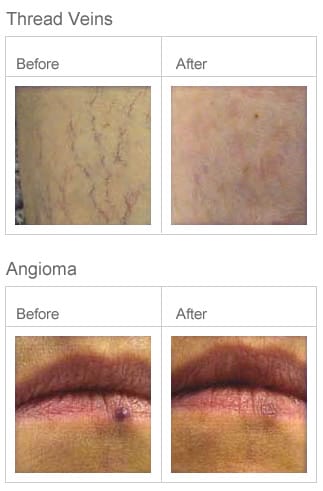Red Veins
Red Vein Removal
Men and women alike rightly feel that veins in the face and legs are cosmetically unattractive even if they are not a major medical problem as a rule. They may arise as a result of skin diseases, hormonal changes, wind, extremes of temperature or even if the skin is sun-damaged. Steroid creams and the hormonal changes that occur during pregnancy can also induce thread veins. Some individuals are genetically more prone to develop thread veins than others and some people are more at risk because of old injuries. If your parents had thread veins, then there is a good chance that you will develop them. It is possible that hormone treatments, such as the contraceptive pill and HRT can increase the likelihood of forming thread veins.
Thread veins, broken veins or telangiectasia are the small red or blue veins which can appear anywhere on the body but are most common on the face and legs. Thread veins can appear as single veins, widely dispersed or as a collection of broken veins close together. They can also appear as a collection of vessels arising from a single point; these are known as Spider Naevi . Other forms of lesion include Haemangioma, and Angiomas, which are benign skin lesions consisting of dense, usually elevated masses of dilated blood vessels.
Port Wine Stains (Birth Mark) are caused by a genetic abnormality of the blood vessels where multiple small ‘loops’ of capillaries develop before birth. The increased quantity of blood flowing just beneath the skin surface is clearly visible through the skin. Although they begin pink in colour, if left untreated they usually darken over the years and often develop nodules, or granulomas, inside them. We can treat port wine stains however they do not always treat predictably and can require between 2 and 10 treatments to improve well. A combination of IPL and laser treatment is often beneficial to achieve best results.
Traditional methods of treatment include:
- Electrodessication
- Sclerotherapy
- Dermabrasion
Results from these methods have proven to be uncomfortable and rarely produce complete clearance of the blood vessels. There are also potential side effects such as bruising, hyper-pigmentation or scarring. Beauty Within Cosmetic clinic can remove thread veins quickly and simply using the Dornier Medilas Skinpulse laser. The procedure can be uncomfortable depending on the size and location of the lesions being treated. In certain areas quite often one treatment is enough to achieve full clearance. Compared to other types of laser treatment this procedure is often surprisingly inexpensive. There is no denying the fact that the procedure can be uncomfortable, however your ability to tolerate any pain largely depends on your pain threshold but in any case, we have ways of reducing the pain including:
- Cooling ice Packs: this reduces the heat generated.
- The client may take Paracetamol an hour before treatment (definitely NOT Aspirin or Brufen type drugs)
- Post treatment cooling: also reduces incidence of blistering
- Post treatment use of Sterex, an aloe vera based gel.
How does it work?
Blood vessels in the upper layer of the skin are sealed off by the effect of heat. This selective absorption is achieved due to the fact that the veins absorb the laser light much more than the tissue around them. The heat shrinks and seals the blood vessels without damaging the surrounding tissue. High but controlled energy densities are delivered by the laser to seal off the blood vessels and avoid unwanted side effects such as purpura (bruising). In this way also deeper lying vessels up to a diameter of about 1.5 mm can be successfully treated.
How is the treatment performed, and does it hurt?
The areas to be treated are first shaved, if necessary. Depending on the location and structure of the veins, and particularly if the patient is sensitive to pain, a topical anaesthetic or some form of cooling is applied to numb the surface of the skin. Generally the small veins do not require any anaesthetic or cooling, and the treatment for these lesions is relatively pain free. During treatment the laser therapist follows the line of the veins with a special focussing applicator or hand piece. Every time a laser pulse is emitted, the vein shrinks, so that the blood is expelled and the vein sealed off.
How effective is the treatment and how quickly will the results be evident?
The appearance of the treated area will vary individually from patient to patient, depending on the scale and characteristics of the vascular disorder or lesion. The skin reddens slightly immediately after treatment. This generally disappears after a few hours. In addition, a crust may form after the treatment of larger, more deeply located veins, especially in the legs, but this heals within a few days. The number of treatments required will depend on the site and the extent of the affected area and will be estimated at your consultation. Larger leg veins usually require at least 3 treatments or possibly more. Subsequent treatments are usually planned at four week intervals. In these cases, the complete treatment may take 2 – 3 months. Spider veins in the facial area usually disappear completely after one treatment. We do not carry out treatment on patients who are tanned or have recently been exposed to UV.
